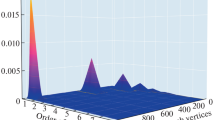Abstract
The proposed method is based on calculations of the statistics of the nearest neighbor graph (NNG) structures, which are presented as a benchmark of the probabilities of the distribution of graphs by the number of disconnected fragments. The deviation of the actually observed occurrence of connectivity from the calculated one will allow us to determine the probability that this sample can be considered a set of statistically independent variables. The statements about the independence of the NNG statistics from the distribution of distances and from the triangle inequality are proved, which allows the numerical modeling of such structures. Estimates of the accuracy of the calculated statistics for graphs and their comparison with estimates obtained by modeling random coordinates of points in d-dimensional space are carried out. It is shown that the model of the NNGs without taking into account the dimension of the space leads to fairly accurate estimates of the statistics of graph structures in spaces of dimensionality higher than five. For spaces of smaller dimensionality, the benchmark can be obtained by directly calculating the distances between points with random coordinates in a unit cube. The proposed method is applied to the problem of analyzing the level of unsteadiness of the earthquake catalog in the Kuril–Kamchatka region. The lengths of samples of time intervals between neighboring events are analyzed. It is shown that the analyzed system as a whole is interconnected with a probability of 0.91, and this dependence is fundamentally different from the lag correlation between the sample elements.






Similar content being viewed by others
REFERENCES
A. A. Kislitsyn, “Investigation of statistics of nearest neighbor graphs,” Math. Models Comput. Simul. 15, 235–244 (2023). https://doi.org/10.1134/s2070048223020084
A. A. Kislitsyn and Yu. N. Orlov, “Discussion about properties of first nearest neighbor graphs,” Lobachevskii J. Math. 43, 3515–3524 (2022). https://doi.org/10.1134/s1995080222150148
E. Fix and J. Hodges, Discriminatory Analysis: Nonparametric Discrimination: Consistency Properties (USAF School of Aviation Medicine, Texas, 1951).
T. Hastie, J. Friedman, and R. Tibshirani, The Elements of Statistical Learning: Data Mining, Inference, and Prediction, Springer Series in Statistics (Springer, New York, 2001). https://doi.org/10.1007/978-0-387-21606-5
G. Guo, H. Wang, D. Bell, Ya. Bi, and K. Greer, “KNN model-based approach in classification,” in On The Move to Meaningful Internet Systems 2003: CoopIS, DOA, and ODBASE, Ed. by R. Meersman, Z. Tari, and D. C. Schmidt, Lecture Notes in Computer Science, Vol. 2888 (Springer, Berlin, 2003), pp. 986–996. https://doi.org/10.1007/978-3-540-39964-3_62
V. Vaidehi and S. Vasuhi, “Person authentication using face recognition,” in Proc. World Congress on Engineering and Computer Science (2008).
Z. Yong, L. Youwen, and X. Shixiong, “An improved KNN text classification algorithm based on clustering,” J. Comput. 4, 230–237 (2009).
F. Bajramovic, F. Mattern, N. Butko, and J. Denzler, “A comparison of nearest neighbor search algorithms for generic object recognition,” in Advanced Concepts for Intelligent Vision Systems, Ed. by J. Blanc-Talon, W. Philips, D. Poposcu, and P. Scheunders (Springer, Berlin, 2006), Vol. 4179, pp. 1186–1197. https://doi.org/10.1007/11864349_108
T. Bailey and A. K. Jain, “A note on distance-weighted k-nearest neighbor rules,” IEEE Trans. Syst., Man, Cybern. 8, 311–313 (1978). https://doi.org/10.1109/tsmc.1978.4309958
V. F. Kolchin, Random Graphs (Fizmatlit, Moscow, 2004).
M. Kenui, Fast Statistical Computations: Simplified Methods for Estimation and Testing (Statistika, Moscow, 1979).
H. B. Mann and D. R. Whitney, “On a test of whether one of two random variables is stochastically larger than the other,” Ann. Math. Stat. 18, 50–60 (1947). https://doi.org/10.1214/aoms/1177730491
R. A. Fisher and F. Yates, Statistical Tables for Biological, Agricultural and Medical Research (Oliver and Boyd, Edinburg, 1946).
L. N. Bol’shev and N. V. Smirnov, Tables of Mathematical Statistics (Nauka, Moscow, 1965).
F. G. Foster and A. Stuart, “Distribution-free tests in time-series based on the breaking of records,” J. R. Stat. Soc., Ser. B (Methodological) 16, 1–13 (1954). https://doi.org/10.1111/j.2517-6161.1954.tb00143.x
A. A. Kislitsyn, A. B. Kozlova, M. B. Korsakova, and Yu. N. Orlov, “Disorder indicator for nonstationary stochastic processes,” Dokl. Math. 99, 57–59 (2019). https://doi.org/10.1134/s1064562419010174
Global Centroid Moment Tensor Catalogm GCMT catalog. https://www.globalcmt.org/CMTsearch.html.
O. R. Musin, “The problem of the twenty-five spheres,” Russ. Math. Surv. 58, 794–795 (2003). https://doi.org/10.1070/rm2003v058n04abeh000651
V. S. Korolyuk, N. I. Portenko, A. V. Skorokhod, and A. F. Turbin, Reference Book on the Probability Theory and Mathematical Statistics (Nauka, Moscow, 1985).
Funding
This study was supported by the Russian Science Foundation (grant no. 23-27-00395).
Author information
Authors and Affiliations
Corresponding author
Ethics declarations
The author of this work declares that he has no conflicts of interest.
Additional information
Publisher’s Note.
Pleiades Publishing remains neutral with regard to jurisdictional claims in published maps and institutional affiliations.
Rights and permissions
About this article
Cite this article
Kislitsyn, A.A. Modeling the Nearest Neighbor Graphs to Estimate the Probability of the Independence of Data. Math Models Comput Simul 15 (Suppl 1), S41–S53 (2023). https://doi.org/10.1134/S2070048223070086
Received:
Revised:
Accepted:
Published:
Issue Date:
DOI: https://doi.org/10.1134/S2070048223070086




